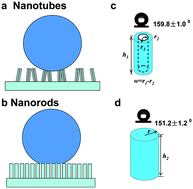Enhanced wettability performance of ultrathin ZnO nanotubes by coupling morphology and size effects
Abstract
In this work, we report on the detailed characterization and mechanism analysis of the improved wettability performance of a new type of ZnO

* Corresponding authors
a
Department of Physics and Siyuan Laboratory, Jinan University, Guangzhou, Guangdong 510632, China
E-mail:
wenjiemai@gmail.com
b State Key Laboratory of Optoelectronic Materials and Technologies, School of Physics Science & Engineering, Sun Yat-Sen (Zhongshan) University, Guangzhou 510275, China
c Department of Chemistry, Jinan University, Guangzhou, Guangdong 510632, China
d
Department of Metallurgical and Materials Engineering, University of Alabama, Tuscaloosa, AL 35487, USA
E-mail:
jhsong@eng.ua.edu
In this work, we report on the detailed characterization and mechanism analysis of the improved wettability performance of a new type of ZnO

 Please wait while we load your content...
Something went wrong. Try again?
Please wait while we load your content...
Something went wrong. Try again?
P. Yang, K. Wang, Z. Liang, W. Mai, C. Wang, W. Xie, P. Liu, L. Zhang, X. Cai, S. Tan and J. Song, Nanoscale, 2012, 4, 5755 DOI: 10.1039/C2NR31380D
To request permission to reproduce material from this article, please go to the Copyright Clearance Center request page.
If you are an author contributing to an RSC publication, you do not need to request permission provided correct acknowledgement is given.
If you are the author of this article, you do not need to request permission to reproduce figures and diagrams provided correct acknowledgement is given. If you want to reproduce the whole article in a third-party publication (excluding your thesis/dissertation for which permission is not required) please go to the Copyright Clearance Center request page.
Read more about how to correctly acknowledge RSC content.
 Fetching data from CrossRef.
Fetching data from CrossRef.
This may take some time to load.
Loading related content
